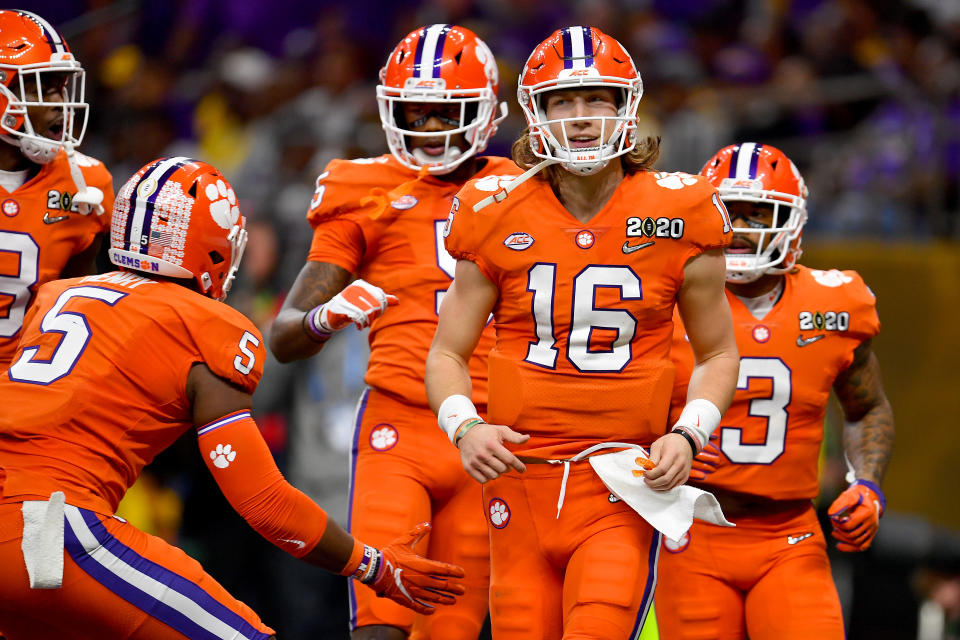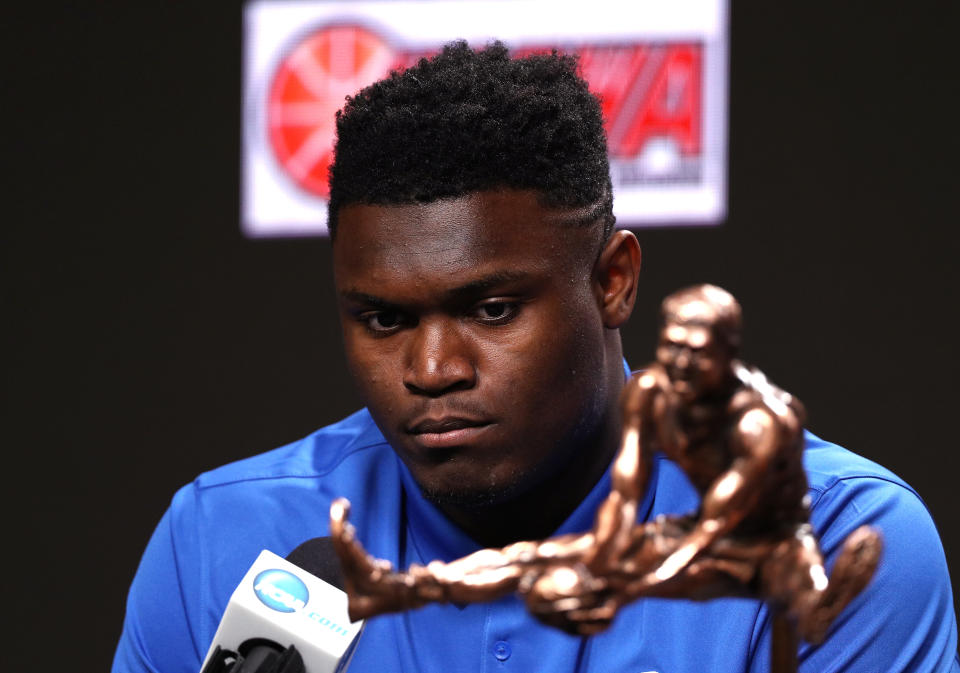How much would Zion, Trevor Lawrence and other college stars make with new NCAA rules?
The NCAA announced on Wednesday the support of a proposal for college athletes to profit off their name, image and likeness. The day marked an important step in the NIL legislation, which should be formally passed in January and put in place in time to start the 2021 football season.
As with most NCAA initiatives, there are still more questions than answers on how this will look in reality. Yahoo Sports spoke to varying athletic officials, agents and marketing experts about what this could really look like.
1) How much could Trevor Lawrence make?
Lawrence won’t be eligible to exploit this new rule, as he’s expected to have declared for the NFL draft by the fall of 2021 when this is enacted. But for the face of the sport in the future – think Auburn’s Bo Nix in 2021 – there’s potential for real money to be earned.
“I think you’re talking at minimum half million, closer to a million dollars,” said Zach Soskin, an athlete ambassador with Voltage Management who has studied this space extensively. “That’s conservative.”
Here’s what Soskin said are some of the misconceptions. It’s unlikely that a top college star will draw much interest from national deals. (There could be exceptions, as we know Lawrence’s blond locks would be a target for shampoo companies.) For the most part, Soskin sees college athletes getting things like trading card, autograph and memorabilia deals. (Think what Johnny Manziel and Todd Gurley were doing, just above board.) Also, local car dealerships and restaurants will be a huge driver.

2) How much could Trevor Lawrence make just off social media?
The very specific answer came from Blake Lawrence, the CEO and co-founder of Opendorse, which helps athletes maximize their value.
He crunched some numbers for Yahoo Sports in a phone interview on Wednesday and concluded Trevor Lawrence could make more than a half-million off of social media endorsements alone this season.
Trevor Lawrence has nearly 500,000 Instagram followers and 81,000 Twitter followers. Blake Lawrence came up with the monetary answer by calculating the engagement rate on each feed. For an Instagram post, Trevor Lawrence could make $16,000. For a Twitter post, it would be about $1,100 per post. He estimated 12 interested local businesses and 50 total posts.
(Blake Lawrence based these numbers off established metrics and payout from NFL players with similar social media followings. Tua Tagovailoa, for example, gets paid about the same now that he’s in the NFL.) Blake Lawrence said that amount could be even more if Lawrence had a YouTube channel.
“The fair-market value is going to be tied back to the audience size and engagement on content you do publish,” said Blake Lawrence, whose company works in the college space with schools that include Clemson and Duke. “Student athletes today are coming into college with significant followings.”
3) How much could Zion Williamson have made at Duke?
A lot. Multiple millions of dollars for certain. He’s the anomaly. (AJ Maestas of Navigate Research estimates $2 million for a clear college one-and-done headed to a high-end NBA career.)
This question is also complicated, as Zion Williamson’s experience has showed. As a once-a-decade type player, there’s no overstating Williamson’s value. The tricky question for the elite athletes will be when they should sign higher-profile deals.
Williamson is a good example of how complicated things will be, as he’s amid a legal entanglement with a marketing group that he fired after agreeing to a five-year deal after his college career ended. Williamson attempted to end that deal and is now with mega-agency CAA, but the lawsuits indicate how things can go wrong.
Williamson had to wait until after Duke to sign a shoe deal, and his $75 million Nike deal was only inflated by the buzz – and busted shoe – from his college career.
“I’m worried about how much a guy like Zion might lose,” said a high-end Division I coach. “Proper representation is going to be needed. The agent has to enter very early.”
4) What’s the future for basketball compensation?
This is tricky. The most followed amateur basketball players aren’t currently in college and are highly unlikely to go there. Those Include LeBron James Jr., Emoni Bates and Mikey Williams. (Bates is clearly the best player, Bronny has the most IG followers at 5.1 million and Williams is a blend of their talent levels and following. None has shown much interest in playing college basketball and it would be shocking if they ended up there.)
Any notion that being able to profit off the NIL will lure kids to college over the new G-League option appears unlikely. One of the appeals of the near $500,000 reported salary for Jalen Green is that it didn’t include endorsements. There’s little chance a kid will go to college and overcome that $500,000 with the endorsements there. If they wanted to go pro, they’re going to go pro.
5) How much will sneaker business be impacted?
The more I asked around about the shoe business, the less it seemed likely that would be a giant factor in NIL for college kids. Schools have massive shoe deals, which is expected to mean if a kid goes to Duke he has to wear Nike there. So a Duke recruit signing with Adidas would mean both limited exposure and helping out a team tied to a rival company.
The recruiting impact could be something. As anyone who followed the federal basketball scandal knows, some of the black market can now be done above ground.
“The thing that Book Richardson and Lamont Evans went to jail for is now [essentially] legal,” said an industry source, referring to breaking NCAA rules. “If Adidas wants to pay Brian Bowen to go to Louisville, they seemingly can. That’s what it feels like. The devil is in the details, and I don’t think they have enough details flushed out for us to know.”
But the point is financial incentives will find their way to the most talented players. Perhaps not through the shoe companies.
6) How will recruiting be impacted?
What the industry source said about Adidas paying Bowen is at least true in spirit. Any notion that the NIL payments won’t cross over into recruiting is hilariously naïve and idealistic.
“It’s a whole new world,” said one industry source. “The law of unintended consequences of this is that you’re making boosters legal. If you’re the CEO of a company that makes a ton of money, you can figure out a way to legally pay a kid.”
Recruiting is going to take on a bottom-line nature. Hypothetically, if Yum Brands wants the Yum Center full of top Louisville talents, guaranteeing all the signees $50,000 in NIL benefits – billboards, ads, etc – seems like a good way to do it.
It’s impossible to separate players getting paid NIL benefits from the recruiting piece. And it’s also one of the times, especially in basketball, when players have the most value. Try this game today. Ask a friend if they can name a single college basketball player returning next season.
I’m guessing they can’t, unless they are a hardcore fan. UConn’s James Bouknight, Florida’s Scottie Lewis and Villanova’s Jeremiah Robinson-Earl – three of the sport’s biggest names – are household names only among their own households and immediate fan bases.
Players should maximize what they can get as soon as they can get it.

7) What will most NIL payments look like?
Blake Lawrence of Opendorse put it this way. There will be two expected categories – physical and digital.
The physical endorsements are things like autograph signings, appearances and promotions from both memorabilia and trading cards. The digital ones are through social media, as discussed earlier with Trevor Lawrence.
For a majority of the players, the primary income streams will come through local appearances and autographs. Joe Burrow, according to Soskin, made about $2.5 million after the draft from both Panini trading cards and memorabilia. That number would have been less at LSU, especially after Burrow’s mediocre junior year. That’s a good estimate of what a high-end young player in a rabid fan base can command in that space as an NFL rookie. So there’d be some fraction of that as a college star. Burrow obviously did those deals knowing he’d be the No. 1 pick.
8) Why do players need to be careful with early deals?
Peter H. Miller of the Jabez Marketing group, whose clients include Dak Prescott, warns high-profile college athletes that early endorsement commitments in college could end up lowering an athlete’s value down the road. “If your ceiling is college, then maximize the opportunity,” he said. “But if you have the ability to transcend to the NFL, I’d pump the brakes.”
He said a deal for $5 per autograph for 10,000 autographs could be very appealing for a college star. But flooding the market with his signature at that low price could severely diminish his value down the line.
He offered this advice for college stars. “What’s more valuable for a college player?” Miller asked. “Really get into marketing and use social media to grow their brand. I wouldn’t worry about the dollars and partnerships. Worry about growing the influencers around your brand.”
9) What could get in the way of NIL legislation going forward?
With the NCAA, it’s always important to read the fine print. The NCAA said in the release it will engage Congress for the “appropriate legal and legislative framework” to take steps forward, which likely includes some limited form of federal antitrust protection. Relying on Congress and the NCAA for a smooth outcome over something this complex is similar to expecting a good experience from a collaboration of the IRS and DMV.
As stumbling blocks to progress go, this could be a huge one. Dislike and distrust of the NCAA is one of the few American pastimes that bridges the political aisle during these defiantly partisan times. Members of Congress were tripping over themselves to rip the NCAA on Wednesday as a way to rally their constituents. “Why are we paying all these people at the NCAA if they can't give us more detail than this?” Florida congresswoman Donna Shalala told SI.com’s Ross Dellenger. “I'd be standing in the middle of my office scratching my head.”
10) What did college sports leaders think about NCAA’s rollout?
There were way more complaints that compliments, as the NCAA was heavy on rhetoric and light on details. The NCAA was forced into this, and leaders around the country were underwhelmed with the level of detail that the NCAA’s release entailed on Wednesday.
There was an overwhelming feeling of being underwhelmed, as one college sports official said there were only “half-answers” to the key questions. They also were perplexed by the timing.
“Tell me what’s right about it,” they said. “The NCAA Board of Governors knows it’s going to make decisions like this, and they announce it at 9 a.m. EST and 6 a.m. Pacific.”
More from Yahoo Sports:

 Yahoo Sports
Yahoo Sports 